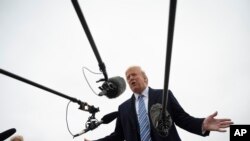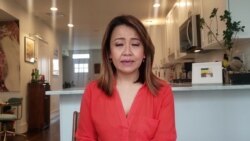It was a beautiful, warm spring Saturday and the calm waters of Willoughby Bay reflected the early afternoon sunlight in a thousand silver streaks. Small waves danced with each gentle breeze; the sky was cloudless and vibrant, the brightest of blues.
It would have been the perfect day for a picnic, but for about a hundred people gathered around Pier 8 of Norfolk Naval Base in Virginia, it was anything but. We were all focused on President Donald Trump, who was about to send a naval hospital ship, the USNS Comfort, to assist the state of New York in their COVID-19 relief effort.
"This great ship behind me is a 70,000-ton message of hope and solidarity to the incredible people of New York," Trump said, standing on a podium with Defense Secretary Mark Esper.
Like many Americans who can’t always social distance themselves at work, I was part of the traveling press pool that day, accompanying the president on his short trip on Air Force One from Joint Base Andrews in Maryland, to Norfolk, VA.
Two days earlier, the White House Correspondents Association, an entity independent of the White House, had passed on word that the White House was cutting the press pool from the usual 13 to seven people, to accommodate social distancing on the plane, where we were instructed to sit on every other seat.
Upon arrival at JBA, I had to submit paperwork documenting travel in the past 14 days and whether I had any COVID-19 symptoms. I was given a squirt of hand sanitizer and my temperature was taken, before being pronounced admissible to enter the passenger terminal where Secret Service agents performed their usual security screening.
I knew that being on a plane is a bad idea at this time, and I admit I was nervous. In the screening process, I had come into less-than-six-feet contact with five officers, only two of whom wore masks. I reached for my hand sanitizer and thought about my son, who is 12. He had given me this advice: "If you have to be around people, mommy, just hold your breath."
We crossed the tarmac and stood shoulder to shoulder under the wing as Trump disembarked from his Marine One helicopter. We huddled even closer as he approached us and answered our questions. Everyone, including the president, was shouting in order to be heard over the sound of the engine overhead. Any one of us could have given the coronavirus to him, or the other way around.
Aboard Air Force One I thought of an article I had written recently, on how President Woodrow Wilson continued sending soldiers aboard ships to fight World War I despite the 1918-1919 Spanish Flu pandemic that killed 675,000 Americans. A historian I interviewed called those ships "caldrons of virus transfers.”
I wiped my seat area and the boxed meal the crew had left for me with disinfectant, and tried not to think of that image in this enclosed space I was sharing not just with journalists, but also White House staff, Secret Service officers and the crew of Air Force One.
I tried to focus; I rechecked my gear. Virus or no virus, being the radio pool reporter on a presidential trip is always stressful. A radio pool reporter is responsible for capturing and uploading to a group server a broadcast quality recording of every word the president utters, within minutes of his saying them. Unlike the print pool reporter and TV correspondents who can focus on asking questions, and the TV technicians who focus on equipment and their craft, radio poolers have to do both, and well. Since other outlets are depending on you, it’s not just your reputation that’s on the line, it’s your organization's too.
We landed at Chambers Airfield and ran to press vans for the short ride to Pier 8 at Norfolk Naval Station. We listened to the president’s short remarks, and we watched the massive ship glide away from the pier while a military march song played. We were whisked back and boarded the plane.
On the way back from Norfolk, the president came to the press seating area at the back of the plane for an off-the-record chat. We gathered around him, again disregarding social distancing guidelines. But off-the-records are rather rare, and in those few minutes I forgot all about the virus, caring only that I did my job — which I am always grateful for, pandemic or not.








